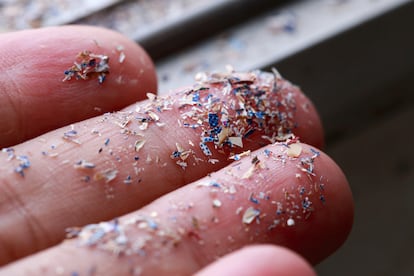More in the brain and less in the liver: How microplastics accumulate in the body
A study has detected up to 30 times more of these elements in brain samples than in those from other organs such as the liver or kidneys

The more plastic we produce, the more we find inside us. Years ago we began to ingest microplastics and nanoplastics hidden in our food. These passed into our digestive system, and from there they entered the bloodstream, which ended up distributing them throughout our insides. One study found them in our lungs, then in our intestines. Another warned of their presence in the placenta, in breast milk, in the testicles… It seems that there is not a single corner of our body that is immune to this invasion. The blood distributes it, but as happens with the tides, there are shores where more waste accumulates than others. And there is one that stands out for its large accumulation of microplastics: our brain.
An analysis published Monday in the scientific journal Nature records a general increase in the concentration of microplastics in cadavers over the past eight years. This increase was especially evident in brain samples, where a much higher concentration was seen than in other areas studied such as the liver or kidneys. The difference is not anecdotal. Concentrations were seven to 30 times higher in brain samples than the concentrations observed in the liver or kidney. The possible implications for human health of this disturbing finding are still unclear.
The team analyzed brain samples from people who died in 2016 and 2024 and found a significant increase. They then looked back even further and analyzed brain tissue samples from earlier periods (1997-2013) and found that there was a lower concentration of microplastics in the past.
“This is, simply, because we are more exposed to plastic,” said Matthew J. Campbell, a biologist at the New Mexico Center for Metals and lead author of the study, at a presentation to journalists. “This is bad news, but the good news is that we did not see higher concentrations of nanoplastics in older adults compared to younger patients, which may mean that our bodies eliminate them over time.”
Microplastics are tiny plastic particles ranging in size from 0.1 micrometers (a human hair is about 60) to five millimeters (a grain of rice is around six). They are produced by the breakdown of larger plastic waste. Global plastic production doubled between 2000 and 2019 to reach 460 million tons. It is estimated that more than 22% of the plastic produced ends up in the environment through poor waste management and from there enters the food chain. A recent study by Portland State University detected microplastics in 99% of samples of seafood purchased in-store or from a fishing boat. The highest levels were found in shrimp.
The new study confirms what others have suggested previously: that we are filled with plastic and that the amount is increasing. What makes it relevant is not determining how much we have, but where. “It is good to know the concentrations and locations of plastic in the human body,” explains Eva Jiménez-Guri, a research biologist at the University of Exeter. Jiménez-Guri, who was not involved in the study, considers it logical that there is a higher concentration in the brain than in the kidneys or liver. “Plastic is hydrophobic, so it seems more normal to me that it accumulates in a tissue that is 60% fat than in one that is 0.7% or 2.7% fat,” she points out. She values the work positively and believes that, in the future, plastic concentration in other tissues should be studied. “Once we know how much plastic there is inside the tissues, work can be done to see what consequences this accumulation has, which will be the really interesting part,” she explains.
Roberto Rosal, a chemical engineer at the University of Alcalá, Spain, is more skeptical. “I have doubts about how these samples were handled, because there are plastics everywhere,” he says. “The fact that the samples were taken from the brains of deceased people that are in a bank, and that they were not taken specifically for them…” Rosal believes that this is a common mistake when talking about microplastic contamination. He explains that this material is present in the environment of any laboratory and believes that this can contaminate the samples and artificially inflate the results, something that has happened in this and many other analyses. Both the present study and others cited by Rosal have been peer-reviewed.
Brain plastic
The study showed higher concentration levels of micro and nanoplastics in the brains of individuals with dementia. “This may be a consequence of brain tissue atrophy, failures in the blood-brain barrier, and failures in detoxification mechanisms, typical of dementia,” says Jiménez-Guri. In other words, it is not the plastic that causes dementia, but rather the plastic that allows invading elements to enter the brain. In any case, the authors point out that the results only identify an association. “We have to be very cautious when interpreting these results,” Campbell clarified before acknowledging that more studies are needed to establish causality.
What these plastics can do to our brains is still a mystery, but we can look at what has happened to other animals in these circumstances. A 2023 study confirmed the presence of nanoplastics in the brains of zebrafish and concluded that this induced oxidative damage and accelerated brain aging. Another study this month, conducted in mice, revealed that immune cells in the brain “gobble up” microplastics, forming clumps that can cause brain clots. The findings, published in the journal Science Advances, highlight how microplastics can indirectly damage the brain by disrupting blood flow. Again, more research is needed to determine whether this can be applied to humans.
We keep finding plastics inside us, but we still don’t know what consequences this may have. The scientific uncertainty surrounding the whole issue leaves room for a certain cultural hysteria. These plastics may be slowly poisoning us. But they may also be harmless. In addition, the fact that we are stuffed with plastic has a strange allegorical resonance. It seems to suggest that our very lifestyle is poisoning us, that the garbage we produce, after filtering and contaminating all of nature, ends up returning to us and parasitizing our insides, as if it were a capitalist version of a life cycle. In this sense, there is nothing more symbolic than a 2019 study, which explained that an average person may be consuming up to five grams of plastic per week, equivalent to the weight of a credit card.
Sign up for our weekly newsletter to get more English-language news coverage from EL PAÍS USA Edition
Tu suscripción se está usando en otro dispositivo
¿Quieres añadir otro usuario a tu suscripción?
Si continúas leyendo en este dispositivo, no se podrá leer en el otro.
FlechaTu suscripción se está usando en otro dispositivo y solo puedes acceder a EL PAÍS desde un dispositivo a la vez.
Si quieres compartir tu cuenta, cambia tu suscripción a la modalidad Premium, así podrás añadir otro usuario. Cada uno accederá con su propia cuenta de email, lo que os permitirá personalizar vuestra experiencia en EL PAÍS.
¿Tienes una suscripción de empresa? Accede aquí para contratar más cuentas.
En el caso de no saber quién está usando tu cuenta, te recomendamos cambiar tu contraseña aquí.
Si decides continuar compartiendo tu cuenta, este mensaje se mostrará en tu dispositivo y en el de la otra persona que está usando tu cuenta de forma indefinida, afectando a tu experiencia de lectura. Puedes consultar aquí los términos y condiciones de la suscripción digital.
More information
Archived In
Últimas noticias
EU’s prestige at stake with proposal to fund Ukrainian war effort with Russian assets
Mustafa Suleyman: ‘Controlling AI is the challenge of our time’
Venezuela breaks energy agreements with Trinidad and Tobago due to alleged complicity with the US
The murder of Michele and Rob Reiner: A tale of horrific days in Hollywood
Most viewed
- ‘El Limones’ and the growing union disguise of Mexican organized crime
- Christian Louboutin: ‘Young people don’t want to be like their parents. And if their parents wear sneakers, they’re going to look for something else’
- ‘We are dying’: Cuba sinks into a health crisis amid medicine shortages and misdiagnosis
- A mountaineer, accused of manslaughter for the death of his partner during a climb: He silenced his phone and refused a helicopter rescue
- The low-cost creative revolution: How technology is making art accessible to everyone











































